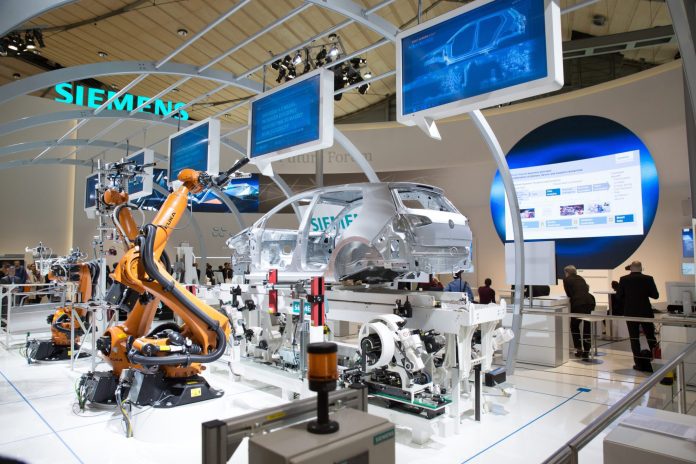In January, Gartner said 2018 would be the year of AI, digital twins, blockchain and edge computing. Fast forward to April, and the leading lights of the Industry 4.0 movement are collected in cavernous rooms at Hannover Messe. We take to the show floor to find out which tech horses they are backing.
Additive manufacturing
Additive manufacturing, or 3D printing, is making a major impact in the industrial space, as demonstrated by Oracle at Hannover Messe. Partnering with Mitsubishi, the company linked a 3D printer to a ‘cobot’ (see below). When the bot needed spare parts, instead of relying on inventory or waiting for a new part to arrive, the 3D printer created them on the fly.
“This type of set-up saves time and money,” noted Lionel Chocorn, vice president of industry and IoT coud solutions at Oracle. “Normally you would have to get the parts from the inventory or wait for another to arrive, losing production time and revenue.”
Darko Sucic, director of technical sales at Dassault Systèmes, commented on how the technology could change the manufacturing industry. “This is the way new for manufacturing things; you can shorten life cycles and impacting your product from the design,” he said.
“It can also improve collaboration between manufacturing and design, with less room to make mistakes. The equipment defines what you can design, and there is transparency from beginning to end.”
Blockchain ledgers
Blockchain has been one of the major Industry 4.0 trends at Hannover Messe. “Blockchain is a big part of the supply chain – trusted networks of information which can optimise how efficient the supply chain is running. We now have a way to trace and track,” explained Anant Kadiyala, director of digital and IoT industry solutions at Oracle.
Kadiyala points to the example of French company Lactalis, which owns the Mon Petit brand; the company was forced to recall baby milk powder from 83 countries over salmonella contamination at a manufacturing plant in France. “It took the company six months to identify health implications, and then another three months to recall,” he said.
“If blockchain had been used, it could have tracked the products for quality control. It would have taken weeks rather than months for recall.”
Blockchain isn’t just limited to fast-moving consumer goods. On its booth, Hewett Packard Enterprise (HPE) showcased its partnership with start-up Relimetrics, combining video analytics and a distributed ledger solution to bring transparency to the supply chain.
The optical quality assessment tool uses an innovative image recognition process to check the configuration and material properties of manufactured components, with the distributed ledger verifying quality in an auditable way.
“Blockchain ledgers can stop recalls in all matter of industries, such as automotive and IT,” said Steve Fearn, chief technologist at HPE’s IoT enterprise group. HPE uses machine learning to identify faults in servers on the production line, and stores the information on a blockchain ledger for quality control purposes.
Collaborative robots
The World Robotics Report 2017, by the International Federation of Robotics (IFR), forecasts 15 per cent growth in the robotics market in the period to 2020, with much of it coming from so-called global collaborative robots, or ‘cobots’. The market for cobots is expected to be worth $6.77 billion by 2025, according to Grand View Research.
Universial Robotics believes cobots will empower factory workers of the future, making it a desirable place to work. “Ten years ago, kids were told not to be a factory worker by their parents – that’s a shame because that’s where the innovation happens,” said Esben Østergaard, the company’s chief technology officer. “Cobots can make the factory a place where creative people can come and work, adding 100 per cent more value.”
Companies at Hannover Messe have been quick to alleviate the fear that comes with employing cobots over people. But the results from a study by IFR showed that only certain activities of a job were automated rather than the entire spectrum of an employee’s role.
The research was done on behalf of the German Federal Ministry for Education and Research and showed that the rise in the use of machines had allowed employment in Germany to grow by one per cent. This development is expected to continue; based on details from companies surveyed, it was estimated that further automation and digitalisation in industries will generate a 1.8 per cent rise in employment by 2021.
Data protection
The General Data Protection Regulation (GDPR) will come into effect in Europe in May 2018. With recent reports of trust violations on social media network, Facebook, the GDPR is on the lips of nearly every company at Hannover Messe. But Fearn at HPE reckons companies shouldn’t fear it, provided they use data wisely.
“GDPR has been long overdue,” he said. “Businesses should only collect data that is reasonable. For example, customer behaviour data should not be affected by GDPR. However, companies have been harvesting data to squeeze revenue out of the consumer, which needs to stop.”
For Fearn, the real challenge with data comes in its processing, to reveal its insights and power. “In the manufacturing world, the challenge is that data already exists, but in silos. HPE’s Edge capability helps companies make sense of the data, with software providing that machine learning is able to develop insights,” he said.
For Oracle’s Kadiyala, companies need to keep an eye on blockchain when it comes to GDPR. “Blockchain is at odds with GDPR and will need to be configured with privacy zones to comply,” said Kadiyala.

